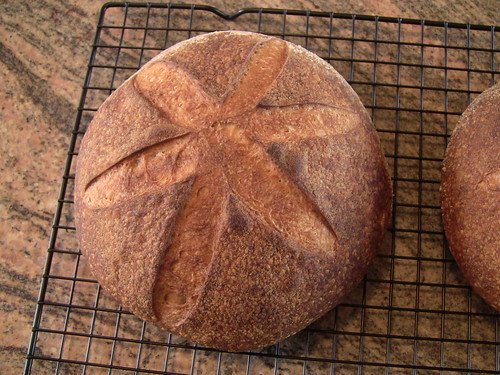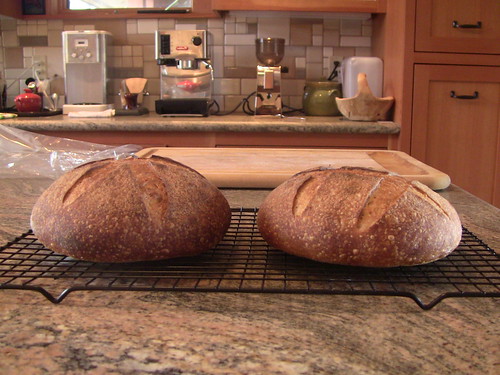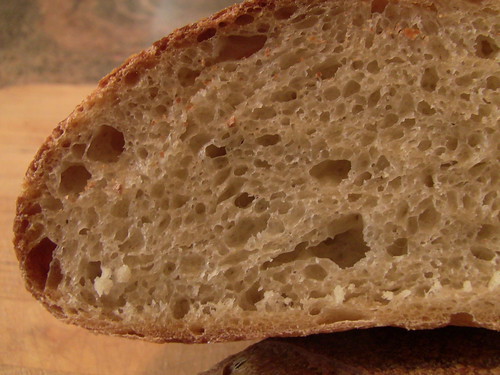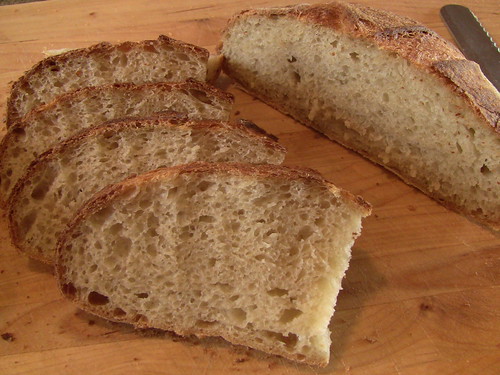
What I Learned Today About Simple Sourdough Breads
Saturday 1/15/11. Today, I am musing on my bread-ucation. Sort of a milepost marking. I have been baking for five months. But I am beginning to feel somewhat knowledgeable about a narrow category of breads, due in large part to (1) The Fresh Loaf and readings recommended here and advice given here, and (2) an enthusiasm for baking that has me making lots of bread as often as I can. I learn stuff every time I handle dough and bake bread.
In that short span of baking experience, here are some things I've learned about baking simple sourdough breads:
- To make bread the way you like it takes lots of study and gathering of general information (reading, watching videos, asking questions, and the like) and even more hands-on trial and error (the error part is very important). It's good to know some bread science--what factors have what results and why--but you can only improve your bread-baking by keeping track of what you do each time and making adjustments the next time.
- You may like bread to be a certain way that others don't, and your tastes may change. Some like big holes in the crumb, others don't; some like really dark crusts, others don't; some like sourer flavor than others do, etc. Make it the way you like it and be your own judge.
- There are lots of variables that affect the crust, crumb and flavor: to name a few: flour choices; hydration; attributes of your starter culture; dough handling at each stage (including mixing, kneading and/or folding, dividing, pre-shaping, shaping, scoring and loading); time of each stage; temperature of ingredients; temperature of environment; type, quality and duration of steam during the bake; characteristics of the oven; attention to, understanding of, and reaction to the sensory information the dough provides; and luck, blessedness, karma, whatever you choose to call it. All of these variables are important, but I think the last two in the list are the most important.
- There is no perfect loaf. Striving for improvement can yield improvement, but can also yield higher expectations. The Earth is round; the horizon keeps receding.
- The more I learn, the more I realize how little I know.
- Bread tastes better when it's been well photographed and shared, and your friends ooh and ahh at it.
This weekend, I am making San Francisco Sourdough from Reinhart's Crust and Crumb. This is the first time I have made something called "San Francisco Sourdough". I have made 20 or 30 sourdough breads, mostly variations on Hamelman's Vermont Sourdough (including Brother David's San Joaquin and my own San Francisco Country). But I love the sour flavor, the crispy crust and the moist, chewy crumb of classic San Francisco Sourdough, and I've lived in San Francisco and environs for most of my life. So isn't it time?
I have read the formula and all the commentary in the book, and I've looked at several TFL blog posts on this bread. What I learned: my brother David really likes this bread (or at least he did in 2008-09 when he blogged many times about it). I chose the formula from Crust and Crumb because (1) I have the book, (2) the formula won some whoop-de-doo award, (3) my brother David really likes this bread and he has good taste, and (4) it's a weekend when I can focus on this formula which takes several days of attention.
In comparison with most of the other sourdoughs I've made, this formula calls for a firmer starter, considerable kneading, and a more passive fermentation approach. There are no stretch and folds during the long (4 hour) primary ferment. I am also--for the first time--making a sourdough with all white flour, and no rye or whole wheat. I am using BRM enriched white flour, made--according to the bag--from high gluten hard red wheat.
I can't say I am following Professor Reinhart's formula exactly (I rarely follow anything exactly). I made a liquid starter from my stock starter, and let it ripen, then chill (but not as long as the formula prescribes). I then made a firm starter from the liquid starter, and let it ripen, then chill (but not as long as the formula prescribes). I suspect the shortened retardation time on the starters will make the bread less sour than it would have been, but I will get to finish the process in time to enjoy the bread before the end of the weekend. Some day I will give this formula all the time it asks, and see if the result is sourer or otherwise different.
I mixed the firm starter, flour, water and salt with my fingers and a plastic scraper. At least 90% of the dough ended up in the bowl at the end of the mixing. I then kneaded it on my granite counter, sprinkled with flour. What I learned. I like kneading dough (I sort of knew that from a few past kneading experiences); it gives immediate visual and tactile feedback on dough development. Unlike stretching and folding over several hours, when you knead dough, you feel the strengthening of the gluten with every few turns. Also, I like kneading on floured granite. Seems like just the right amount of sticky friction. The dough is now fermenting. Giving me time to muse. What I learned as I mused and watched the activity in my sunny courtyard: voles and sparrows will riotously gorge themselves on scattered birdseed, while totally ignoring each other. The sparrows will chase each other away, but the sparrows don't even seem to acknowledge the voles, and vice versa.
Later 1/1/5/11. I have now shaped the 1 pound dough pieces into boules. What I learned. This dough is loose and silky though the hydration is fairly low. Is it because the gluten develops less strength when the dough is not stretched and folded periodically? Or because the all white flour absorbs less water than my usual dough which has 15-25% whole grain? Or because the fermentation (and looseness) is enhanced by the high proportion of stiff levain? I also learned that un-floured granite is an excellent surface for using the boule shaping technique that Brother David has famously video-recorded. I strove for a really taut sheath, but the little blobs seem to think they're 75% water when they're more like 60%.
Now the boules are in their bannetons in their plastic bags, proofing. They will proof in the kitchen until they have once-and-a-halfled (half a doubling). Then they will go in the refrigerator for the night.
Sunday 1/16/11. 90 minutes after being taken out of the refrigerator, the boules were gently flopped from their bannetons onto pieces of parchment, then placed on a cookie sheet and scored. The oven, with baking stone, was pre-heated at 475 F for an hour steamed using Sylvia's magic towels and a cast iron skillet with lava rocks. In addition, contrary to my usual procedure, I misted the loaves with water when they were loaded and again after a couple minutes. After 15 minutes, I removed the steaming apparati and reduced the temperature to 425 F on convection setting. After 30 minutes total (and a 207 F internal loaf temperature), I turned the oven off and left the loaves on the stone with the door ajar for another 10 minutes.
The oven spring was very good, though not the mighty spring of some other sourdoughs I've baked. The loaf scored with a star rose about 20% more than the one with the hash mark (is this a commentary on telephone keypads?). The crust is perfectly colored, deep caramel and quite even, shiny, with little crust bubbles here and there. What I learned. Spritzing loaves seems to add to shine and crust bubbles. The star scoring pattern seems to encourage upward spring. Convection baking (in a good oven) seems to enhance evenness of crust color. I love my North Coast oven.
As the loaves cool, I can take a few minutes to look off to sea, where a large group of grey whales are commuting South, presumably looking for real Wharf Bread. They are spouting off and waving hello with their flukes.
Later 1/16/11. The loaves are mostly cooled. They spray crust crumbs widely as they are sliced. The crumb is moist, airy but chewy. Very much a classic SF sourdough. The holes are mostly small, with a few bigger pockets, but not what you'd call an open crumb. This is just as I like it. The flavor is simple but good. Mildly sour. What I learned. Maybe the longer retardation of the starters is key to stronger sourness. The less open crumb may be linked to the passive bulk retardation (with no stretch-and-folds and thus less gluten strength to hold bigger bubbles).
Update: An hour later, the structure of the crumb has solidified and become a bit denser. I'd say medium dense. Good texture. The flavor's also become a bit more sour.
All in all, this is a bread I'll make again, probably adding some stretch-and-folds and some whole grains. And definitely trying the longer retardation of the starters that the recipe calls for. That would combine the more complex flavors, more gluten strength and the sourness I'm seeking. I learned a lot from this bake.
Glenn






Comments
You have learned so much in such a short time and your skills certainly show in your beautiful loaves. I envy you that you have those SF yeasties floating around in your area! I love the 'birdseye' on the crust too, you can get them from overnight retarding and spritzing...though I consider that cheating, only my humble opinion...ha, ha..do it too!
Sylvia
That's the perfect term for it. As a guitar collector with a couple beautiful maple guitars, I should have seen that connection.
Here's a close-up (bread, not guitar).
Thanks for the nice comments, Sylvia.
Glenn
Beautiful, beautiful bread, Glenn. And some impressive progress in a relatively short span of time. I hope that other novice bakers are encouraged by your bread-ucation.
Paul
I hope so, too. And I hope those that expect a perfect loaf the first try come to understand and enjoy the incremental nature of skill-building, and the value of the interaction with a bread-baking community that TFL offers.
Glenn
Hello Glenn, Two lovely loaves of sourdough you've got there. It's interesting the effect your (beautiful) scoring has on the rise of the loaves.
Your post reminds me of Mr. Hamelman's 'Part One - Ingredients and Techniques' (pages 1 and 2 in his book, talking about interrelationships in the bread-making process). It's been awhile since I read this - thanks for the reminder!
It was good to go back and re-read that passage.
Thanks, from breadsong
I have been reading Bread, which was a Hannukah present, but I did not mean to channel Hamelman. I think his writings, Reinhart's and others'--including the more reflective TFLers--have some consistent themes, which I have been picking up...like lint on black trousers.
Glenn
I'd say the crumb structure hit the bullseye for this bread. Your crust and scoring are lovely, especially the "star."
Reinhart's firm starter and each prescribed retardation increase the acetic acid sourness. If you want to boost it, even try making the starter a day ahead and refrigerating it for 36-48 hours before mixing the dough.
i really should make this bread again, applying what I've learned over the last year or two about the virtues of hand mixing and S&F. But "So many breads. So little time" (and freezer space).
BTW, the formula for the SFBI miche for which you have been patiently(?) waiting is now posted in my TFL blog.
David
I love the crust and crumb on this bread. I would love to (and intend to) figure out how I got this crumb texture and mouthfeel. I can't quite find the words. The crumb is not dense like a pure rye. It's not "tough" but it puts up just the right amount of resistance to chewing. It melts slowly in the mouth.
I haven't used bread flour in hearth breads much. I wonder if I need to try San Francisco Country Sourdough with a higher gluten flour instead of AP or CM's OABC (of which I still have 25 or so pounds...I'll save some for you if you like...it's my favorite for baguettes).
As to sourness, I do intend to try a series of experiments with retarded levain. I guess if I could replicate the flavor of remembered Wharf Bread, it would be an acetic acid flashback.
And thanks for the Miche formula. Maybe next weekend.
Glenn
Great write up on a bread I have been very tempted to try my whole baking career. The loaves look delicious.
And good to hear another guitar player/bread baker in the house!
It is a bread you should try.
Guitar playing and baking are a natural combination. They're all about tactile feedback, evolving dexterity, and creating beauty.
Though mixing dough does dry the fingers out, which is not ideal for gliding on strings. Maybe focaccia would be a better skin therapy.
Glenn
I appreciate your putting to paper your observations about the learning process in creating Sourdough breads. It does seem to me that the process is both simple as the title of your post suggests and complicated as you learn with your hands.
Living in the shadow of a masterful home baker as you do, I take my hat off to you for your transparency of thought. You have come a long way over the last half year and your current breads are impressive Glen. Great post!
Eric
Eric,
I may cast a shadow (too large a one, at the moment, but I'm on a diet), but I prefer Glenn's modified metaphor. I'd like to think I'm lighting the way for others. (Now, back to lightening the weigh.)
David
I do enjoy the experience of growing expertise. And having a place like TFL to describe it and receive encouragement and advice.
I prefer to think I live in the light, not the shadow, of a masterful home baker.
Glenn
And wonderful commentary on your learnings as you work with the dough. There are so many factors at work, as you note, and discerning just what combination of factors yield perceptible differences in the finished product is why baking is a life's work and not something mastered completely ever.
I think the scoring and its differences in the volume of your loaves is a great take-away and something you can use going forward (would I like a more miche-like profile, or something arching upwards more?).
Thanks for sharing - I'm taking notes.
Larry
There are so many things to experiment with, and the effect of scoring (pattern, depth, angle) on baked shape is certainly one of the more interesting.
I appreciate your kind words. I expect to be more and more pleased with my baking, and never fully satisfied.
Glenn
There's a lot to know about sourdough, and I hope you enjoy learning. The good news is you get to eat your homework.
Glenn
You're right, Glenn.. Those microorganisms living in a starter make sourdough baking a form of an art, ever so challenging.